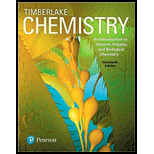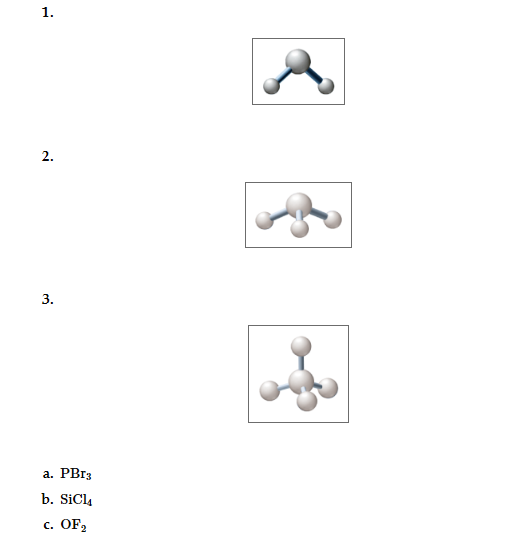
Chemistry: An Introduction to General, Organic, and Biological Chemistry (13th Edition)
13th Edition
ISBN: 9780134421353
Author: Karen C. Timberlake
Publisher: PEARSON
expand_more
expand_more
format_list_bulleted
Concept explainers
Question
Chapter 6, Problem 6.104UTC
Interpretation Introduction
To determine:
The given Lewis structure (a to c) with correct diagram (1 to 3) of its shapes and names of the shapes also indicate each molecule is polar or non-polar, assuming X and Y are non-metals.

Expert Solution & Answer
Want to see the full answer?
Check out a sample textbook solution
Students have asked these similar questions
7. Describe the expected 31P and 19F (where applicable) NMR spectral patterns for the
following compounds (indicate number of signals and their splitting patterns).
a) tetraphenyldiphosphine
Ph
Ph
P-P
Ph
Ph
Ph
Ph
'
b) tetraphenyldiphosphine monoxide
P-P-Ph
Ph
(2 points)
(2 points
c) tetrafluorophosphonium hexafluorophosphate [PF4]*[PF6]¯
(4 points)
3.
For questions 1-4, consider the following complexes:
[Co(CN)6]4,
[COC14]²,
[Cr(H2O)6]²+
Which (if any) of these complexes would be expected to display Jahn-Teller distortion?
(2 points)
What is Instrumental Neutron Activation and what are the advantages and disadvantages in using its applications?
(I'm doing an in class assignment and need better understanding of what the instrument can be used for)
Please include references so that I can better understand the application of how the instrument works!
Chapter 6 Solutions
Chemistry: An Introduction to General, Organic, and Biological Chemistry (13th Edition)
Ch. 6.1 - State the number of electrons that be must be lost...Ch. 6.1 - State the number of electrons that must be gained...Ch. 6.1 - State the number of electrons lost or gained when...Ch. 6.1 - Prob. 6.4PPCh. 6.1 - Write the symbols for the ions with the following...Ch. 6.1 - Write the symbols for the ions with the following...Ch. 6.1 - Prob. 6.7PPCh. 6.1 - State the number of protons and electrons in each...Ch. 6.1 - Write the symbol for the ion of each of the...Ch. 6.1 - Write the symbol for the ion of each of the...
Ch. 6.1 - Write the names for each of the following ions:...Ch. 6.1 - Write the names for each of the following ions:...Ch. 6.1 - State the number of protons and electrons in each...Ch. 6.1 - State the number of protons and electrons in each...Ch. 6.2 - Which of the following pairs of elements are...Ch. 6.2 - Which of the following pairs of elements are...Ch. 6.2 - Write the correct ionic formula for the compound...Ch. 6.2 - Write the correct ionic formula for the compound...Ch. 6.2 - Write the symbols for the ions, and the correct...Ch. 6.2 - Write the symbols for the ions, and the correct...Ch. 6.3 - Write the name for each of the following ionic...Ch. 6.3 - Prob. 6.22PPCh. 6.3 - Write the name for each of the following ions...Ch. 6.3 - Prob. 6.24PPCh. 6.3 - Write the name for each of the following ionic...Ch. 6.3 - Prob. 6.26PPCh. 6.3 - Prob. 6.27PPCh. 6.3 - Prob. 6.28PPCh. 6.3 - Prob. 6.29PPCh. 6.3 - Write the formula for each of the following ionic...Ch. 6.3 - Prob. 6.31PPCh. 6.3 - Prob. 6.32PPCh. 6.3 - The following compounds contain ions that are...Ch. 6.3 - Prob. 6.34PPCh. 6.4 - Write the formula including the charge for each of...Ch. 6.4 - Prob. 6.36PPCh. 6.4 - Prob. 6.37PPCh. 6.4 - Prob. 6.38PPCh. 6.4 - Prob. 6.39PPCh. 6.4 - Prob. 6.40PPCh. 6.4 - Write the correct formula for the following ionic...Ch. 6.4 - Write the correct formula for the following ionic...Ch. 6.4 - Prob. 6.43PPCh. 6.4 - Write the formula for the polyatomic ion and name...Ch. 6.4 - Name each of the following ionic compounds:...Ch. 6.4 - Name each of the following ionic compounds:...Ch. 6.5 - Name each of the following molecular compounds:...Ch. 6.5 - Prob. 6.48PPCh. 6.5 - Prob. 6.49PPCh. 6.5 - Name each of the following molecular compounds: a....Ch. 6.5 - Write the formula for each of the following...Ch. 6.5 - Write the formula for each of the following...Ch. 6.5 - Write the formula for each of the following...Ch. 6.5 - Write the formula for each of the following...Ch. 6.5 - Name each of the following ionic or molecular...Ch. 6.5 - Name each of the following ionic or molecular...Ch. 6.6 - Determine the total number of valence electrons...Ch. 6.6 - Determine the total number of valence electrons...Ch. 6.6 - Draw the Lewis structure for each of the following...Ch. 6.6 - Draw the Lewis structure for each of the following...Ch. 6.7 - Describe the trend in electronegativity as...Ch. 6.7 - Prob. 6.62PPCh. 6.7 - Using the periodic table, arrange the atoms in...Ch. 6.7 - Using the periodic table, arrange the atoms in...Ch. 6.7 - Prob. 6.65PPCh. 6.7 - Prob. 6.66PPCh. 6.7 - Predict whether each of the following bonds is...Ch. 6.7 - Predict whether each of the following bonds is...Ch. 6.7 - For each of the following bonds, indicate the...Ch. 6.7 - For each of the following bonds, indicate the...Ch. 6.8 - Choose the shape (1 to 6) that matches each of the...Ch. 6.8 - Prob. 6.72PPCh. 6.8 - Prob. 6.73PPCh. 6.8 - Complete each of the following statements for a...Ch. 6.8 - Prob. 6.75PPCh. 6.8 - Prob. 6.76PPCh. 6.8 - 6.77 Use VSEPR theory to predict the shape of each...Ch. 6.8 - Use VSEPR theory to predict the shape of each of...Ch. 6.9 - Prob. 6.79PPCh. 6.9 - Prob. 6.80PPCh. 6.9 - Prob. 6.81PPCh. 6.9 - Identify each of the following molecules as polar...Ch. 6.9 - Prob. 6.83PPCh. 6.9 - Prob. 6.84PPCh. 6.9 - Prob. 6.85PPCh. 6.9 - Prob. 6.86PPCh. 6.9 - Prob. 6.87PPCh. 6.9 - Prob. 6.88PPCh. 6.9 - Prob. 6.89PPCh. 6.9 - Prob. 6.90PPCh. 6.9 - Prob. 6.91PPCh. 6.9 - Prob. 6.92PPCh. 6 - Prob. 6.93UTCCh. 6 - a. How does the octet rule explain the formation...Ch. 6 - Prob. 6.95UTCCh. 6 - Prob. 6.96UTCCh. 6 - Prob. 6.97UTCCh. 6 - Prob. 6.98UTCCh. 6 - Prob. 6.99UTCCh. 6 - Prob. 6.100UTCCh. 6 - Prob. 6.101UTCCh. 6 - 6.102 State the number of valence electrons,...Ch. 6 - Prob. 6.103UTCCh. 6 - Prob. 6.104UTCCh. 6 - Prob. 6.105UTCCh. 6 - Prob. 6.106UTCCh. 6 - Prob. 6.107UTCCh. 6 - Prob. 6.108UTCCh. 6 - Prob. 6.109APPCh. 6 - Prob. 6.110APPCh. 6 - Prob. 6.111APPCh. 6 - Prob. 6.112APPCh. 6 - Prob. 6.113APPCh. 6 - Prob. 6.114APPCh. 6 - Prob. 6.115APPCh. 6 - Prob. 6.116APPCh. 6 - Prob. 6.117APPCh. 6 - Prob. 6.118APPCh. 6 - Prob. 6.119APPCh. 6 - 6.120 Write the formula for each of the following...Ch. 6 - Prob. 6.121APPCh. 6 - Prob. 6.122APPCh. 6 - Prob. 6.123APPCh. 6 - Prob. 6.124APPCh. 6 - Prob. 6.125APPCh. 6 - Prob. 6.126APPCh. 6 - 6.127 Draw the Lewis structure for each of the...Ch. 6 - 6.128 Draw the Lewis structure for each of the...Ch. 6 - Prob. 6.129APPCh. 6 - 6.130 Use the periodic table to arrange the...Ch. 6 - Prob. 6.131APPCh. 6 - Prob. 6.132APPCh. 6 - Show the dipole arrow for each of the following...Ch. 6 - Show the dipole arrow for each of the following...Ch. 6 - Prob. 6.135APPCh. 6 - Prob. 6.136APPCh. 6 - Prob. 6.137APPCh. 6 - Prob. 6.138APPCh. 6 - Prob. 6.139APPCh. 6 - Prob. 6.140APPCh. 6 - Prob. 6.141APPCh. 6 - Prob. 6.142APPCh. 6 - Prob. 6.143APPCh. 6 - 6.144 Classify each of the following molecules as...Ch. 6 - Indicate the major type of intermolecular...Ch. 6 - Indicate the major type of intermolecular...Ch. 6 - Prob. 6.147CPCh. 6 - Prob. 6.148CPCh. 6 - Prob. 6.149CPCh. 6 - Prob. 6.150CPCh. 6 - Prob. 6.151CPCh. 6 - Prob. 6.152CPCh. 6 - Prob. 6.153CPCh. 6 - Prob. 6.154CPCh. 6 - Prob. 6.155CPCh. 6 - Prob. 6.156CPCh. 6 - Prob. 7CICh. 6 - Prob. 8CICh. 6 - Prob. 9CICh. 6 - Prob. 10CICh. 6 - Prob. 11CICh. 6 - Of much concern to environmentalists is radon-222,...
Knowledge Booster
Learn more about
Need a deep-dive on the concept behind this application? Look no further. Learn more about this topic, chemistry and related others by exploring similar questions and additional content below.Similar questions
- What is Isotope Analysis and what are the advantages and disadvantages in using its applications and instrumentalization? Please include references so that I can better understand how the instrument works!arrow_forward5. Count the electrons on the following complexes and state whether they follow the 18- electron rule: (3 points) Fe(CO)5 Ni(PMe3)4 PMe3 is trimethylphosphine Mn(CO)5Brarrow_forwardFor questions 1-4, consider the following complexes: [Co(CN)6]+, [CoCl4]², [Cr(H2O)6]²+ 2. Draw the corresponding d-orbital splitting for each of the complexes; predict the spin- state (low-spin/high spin) for each of the complexes (if applicable); explain your arguments. Calculate the crystal field stabilization energy for each complex (in Ao or At). (6 points)arrow_forward
- For questions 1-4, consider the following complexes: [Co(CN)6]4, [COC14]², [Cr(H2O)6]²+ 1. Assign oxidation number to the metal, then indicate d-electron count. (3 points)arrow_forwardUsing iodometry I want to titrate a sodium thiosulfate solution and I use 15 mL. If I have 50 mL of a 0.90 M copper solution and KI, what will be the molarity of sodium thiosulfate?arrow_forwardDraw the product formed when the following pair of compounds is treated with NaOEt in ethanol. + i CNarrow_forward
- I need help with the followingarrow_forwardI need help with the followingarrow_forwardFor Raman spectroscopy/imaging, which statement is not true regarding its disadvantages? a) Limited spatial resolution. b) Short integration time. c) A one-dimensional technique. d) Weak signal, only 1 in 108 incident photons is Raman scattered. e) Fluorescence interference.arrow_forward
arrow_back_ios
SEE MORE QUESTIONS
arrow_forward_ios
Recommended textbooks for you
 ChemistryChemistryISBN:9781305957404Author:Steven S. Zumdahl, Susan A. Zumdahl, Donald J. DeCostePublisher:Cengage Learning
ChemistryChemistryISBN:9781305957404Author:Steven S. Zumdahl, Susan A. Zumdahl, Donald J. DeCostePublisher:Cengage Learning ChemistryChemistryISBN:9781259911156Author:Raymond Chang Dr., Jason Overby ProfessorPublisher:McGraw-Hill Education
ChemistryChemistryISBN:9781259911156Author:Raymond Chang Dr., Jason Overby ProfessorPublisher:McGraw-Hill Education Principles of Instrumental AnalysisChemistryISBN:9781305577213Author:Douglas A. Skoog, F. James Holler, Stanley R. CrouchPublisher:Cengage Learning
Principles of Instrumental AnalysisChemistryISBN:9781305577213Author:Douglas A. Skoog, F. James Holler, Stanley R. CrouchPublisher:Cengage Learning Organic ChemistryChemistryISBN:9780078021558Author:Janice Gorzynski Smith Dr.Publisher:McGraw-Hill Education
Organic ChemistryChemistryISBN:9780078021558Author:Janice Gorzynski Smith Dr.Publisher:McGraw-Hill Education Chemistry: Principles and ReactionsChemistryISBN:9781305079373Author:William L. Masterton, Cecile N. HurleyPublisher:Cengage Learning
Chemistry: Principles and ReactionsChemistryISBN:9781305079373Author:William L. Masterton, Cecile N. HurleyPublisher:Cengage Learning Elementary Principles of Chemical Processes, Bind...ChemistryISBN:9781118431221Author:Richard M. Felder, Ronald W. Rousseau, Lisa G. BullardPublisher:WILEY
Elementary Principles of Chemical Processes, Bind...ChemistryISBN:9781118431221Author:Richard M. Felder, Ronald W. Rousseau, Lisa G. BullardPublisher:WILEY

Chemistry
Chemistry
ISBN:9781305957404
Author:Steven S. Zumdahl, Susan A. Zumdahl, Donald J. DeCoste
Publisher:Cengage Learning

Chemistry
Chemistry
ISBN:9781259911156
Author:Raymond Chang Dr., Jason Overby Professor
Publisher:McGraw-Hill Education

Principles of Instrumental Analysis
Chemistry
ISBN:9781305577213
Author:Douglas A. Skoog, F. James Holler, Stanley R. Crouch
Publisher:Cengage Learning

Organic Chemistry
Chemistry
ISBN:9780078021558
Author:Janice Gorzynski Smith Dr.
Publisher:McGraw-Hill Education

Chemistry: Principles and Reactions
Chemistry
ISBN:9781305079373
Author:William L. Masterton, Cecile N. Hurley
Publisher:Cengage Learning

Elementary Principles of Chemical Processes, Bind...
Chemistry
ISBN:9781118431221
Author:Richard M. Felder, Ronald W. Rousseau, Lisa G. Bullard
Publisher:WILEY